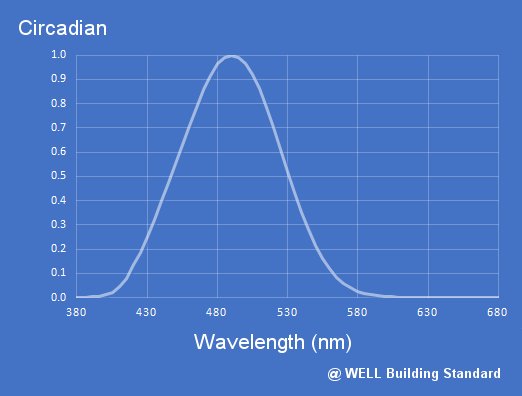| |
Equivalent Melanopic Lux Metrics
|
|
| |
Equivalent Melanopic Lux (EML) is adopted by WELL Building Standard to assess the circadian entrainment of a
lighting environment, and it is weighted to the spectral response of the ipRGC cells in the retina. EML metrics is
based on the spectral power and Circadian Index (or also known as Melanopic Sensitivity) of individual wavelength to
come up with the Melanopic Ratio. Then The EML value is equal to the product of Illuminance (Lux) and Melanopic Ratio.
|
|
| |
| |
| Circadian Index |
|
The Circadian Index used in the calculation of Melanopic Ratio is shown in the graph on the right, and it starts
to rise from 0.0795 (at 415 nm) to 0.6297 (at 455 nm) and then to 1 (at 490 nm). Higher Circadian Index value
represents higher efficiency to suppress Melatonin.
Therefore, the Circadian Index shows that blue-turquoise light (456 - 490 nm) is more efficient than blue-violet
light (415 - 455 nm) to suppress Melatonin and thus regulate the circadian rhythm.
|

|
|
|
|
|
| |
| High Melanopic Ratio |

|
LiteBlue LED has exceptionally high blue-turquoise light percentage of roughly 90% in the blue light content, thus
capable to generate higher Melanopic Ratio than standard LED of 450 nm blue pump.
LiteBlue LED is of 24% - 26% higher
Melanopic Ratio than standard LED. Therefore, equivalent circadian entrainment at a lower light intensity level can be
achieved. In other words, LiteBlue LED offers the benefits of saving energy and reducing eye discomfort to users, when
higher light intensity level of standard LED is used.
|
| |
|
|
| |
| LiteBlue LED Part number
|
Color
Temperature
|
Equivalent Melanopic Lux (EML)
Melanopic Ratio (MR)
|
| CCT
|
LiteBlue LED
(465 nm pump)
|
Standard LED
(450 nm pump)
|
Increase/Decrease
|
| LB2835-50-465
|
5000K
|
1.03
|
0.82
|
+26%
|
| LB2835-40-465
|
4000K
|
0.84
|
0.68
|
+24%
|
| LB2835-30-465
|
3000K
|
0.65
|
0.51
|
+26%
|
|
|